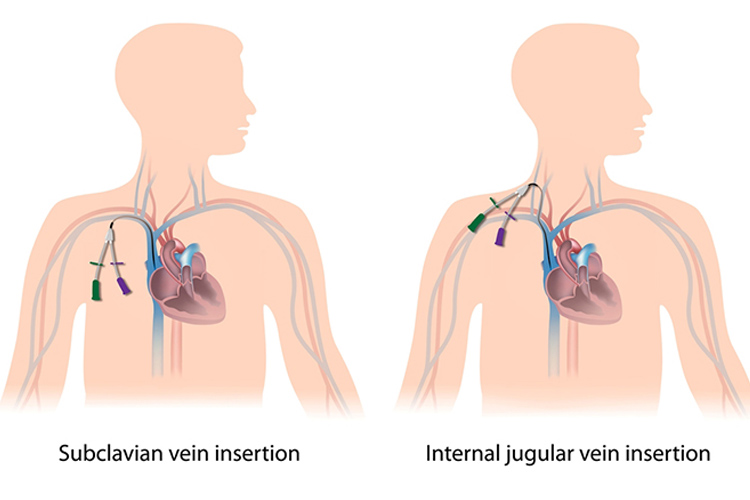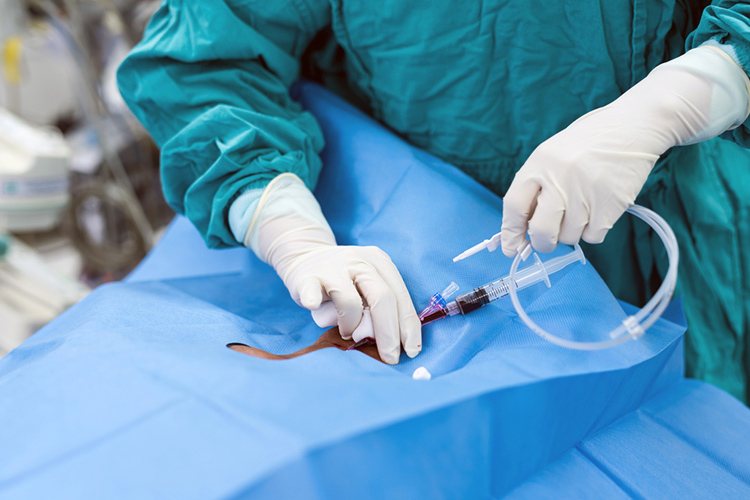What is a Central Line-Associated Bloodstream Infection?
A central line, like the name implies, is a catheter that gains direct entry into the bloodstream with the tip of the line sitting either within the superior vena cava or inferior vena cava, or within one of the great vessels of the neck.
Because of its central location, this type of catheter can occasionally allow pathogens to gain direct entry into the bloodstream. If this occurs, patients become unwell very quickly.
This is why prompt assessment, recognition and treatment of central line-associated bloodstream infections (CLABSI) is essential to help ensure favourable patient outcomes.
The Australian Commission on Safety and Quality in Health Care (ACSQHC) (2019) states that one of the following criteria needs to be met for a patient to be diagnosed with a CLABSI:
| Criterion 1 | |
|---|---|
|
|
|
OR
| Criterion 2 | |
|---|---|
|
|
|
|
|
(ACSQHC 2019)
As you can imagine, the cost of CLABSI in both healthcare dollars and patient morbidity is high. Each CLABSI episode increases the length of the patient’s hospitalisation and substantially increases the cost of their healthcare (Haddadin et al. 2022). Therefore, it’s important to be aware of the causes of CLABSI and how we can prevent them from occurring (ACSQHC 2019).
What Causes a Central Line-Associated Bloodstream Infection?
There are many different ways in which contamination of the central line can occur and cause infection. These include:
- Contamination upon insertion
- The patient’s skin flora
- The healthcare professional accessing the central venous access device
- Colonisation of the central venous access device (CVAD) hub
- Contaminated infusion or components of the IV set
- Haematogenous spread from other sites (e.g. through the bloodstream from another infection)
- Non-intact dressing.
(Haddadin et al. 2022)
Patient-related risk factors for developing a CLABSI include:
- Immunosuppression
- Older or very young age
- Poor nutrition
- Impaired skin integrity (e.g. burns)
- Antibiotic therapy
- Chronic illness, such as diabetes
- Total parenteral nutrition
- Position of the central line (femoral and internal jugular catheters carry the highest risk)
- Lengthy hospitalisation before venous catheterisation.
(Haddadin et al. 2022)
Other risk factors include:
- Poor hand hygiene from healthcare workers
- Non-adherence to aseptic techniques
- Emergency catheter insertion
- Poor catheter care
- Prolonged duration of the catheter.
(Haddadin et al. 2022; Moriyama et al. 2022)

Central Line-Associated Bloodstream Infection Symptoms
Central line-related infections can be either localised or systemic (Nickson 2024).
Localised symptoms may include:
- Pain
- Redness
- Swelling
- Discharge at the central line exit site.
(Haddadin et al. 2022)
If a localised infection is suspected, a swab can be taken from the central line exit site if exudate is present.
Systemic symptoms may include:
- Fever
- Chills/rigors
- Hypotension
- Altered cognitive state
- Fatigue/lethargy.
(Haddadin et al. 2022)
If a CLABSI is suspected, a full septic screen of the patient should occur. This will often involve the following investigations:
- A set of blood cultures from each lumen of the CVAD
- A set of blood cultures from peripheral blood
- A swab of the central line exit site if there is exudate present
- Vital signs
- A full blood count
- Electrolytes, urea and serum creatinine
- Liver function
- Midstream urine specimen
- Chest x-ray
- Sputum
- Other wound swabs.
(Haddadin et al. 2022; ACSQHC 2019)
How are Central Line-Associated Bloodstream Infections Treated?
Treatment of a CLABSI needs to commence promptly. Specific management will depend on the causative pathogen, patient factors and the patient’s overall clinical status. Blood cultures should be taken to identify the causative organism, and empiric treatment should be commenced while awaiting these results. Generally, antibiotics that cover both gram-positive and gram-negative bacteria will need to be administered. More specific therapy can be commenced once blood culture results are available (Haddadin et al. 2022).
The CVAD may also be removed. If it is to be removed, then the catheter tip may be sent to pathology for cultures. Prior to removal, blood cultures may also be taken via the CVAD (Haddadin et al. 2022).

Nursing Care and Central Line-Associated Bloodstream Infection Prevention
One of the most important factors in managing a central line is the nursing management of the device and the patient. This not only includes assessing the patient for risk factors for potentially developing an infection, but also means ensuring preventative measures are in place and using an aseptic non-touch technique when managing the central line.
Maintenance checklists and insertion bundles can also standardise central line care and have been found to reduce the incidence of CLABSI (ANZICS 2024).
The nurse must manage the central line according to local policies and procedures. This may include:
- Disinfecting hubs, needle connectors and injection ports prior to accessing the central line
- Replacing administration sets other than those used for lipids or blood products every 96 hours
- Assessing whether the central line is required daily.
(Haddadin et al. 2022)
Healthcare professionals should also educate patients on how to manage their central line and how they can help protect themselves against a possible CLABSI. Encourage patients to:
- Speak up about any concerns
- Ask about the pros/cons of the central line, why it’s needed and how long it may be in situ for
- Avoid touching the tubing as much as possible
(CDC 2024)
The healthcare professional must also monitor for any signs or symptoms of a CLABSI, as well as other complications such as air embolism, catheter damage, catheter migration and occlusion.
In the management of central lines and prevention of CLABSI, the role of the healthcare professional is essential.
Test Your Knowledge
Question 1 of 3
Which one of the following practices is recommended for preventing CLABSI?
Topics
References
- Australia and New Zealand Intensive Care Society 2024, CLABSI, ANZICS, viewed 30 April 2025, https://www.anzics.com.au/clabsi/
- Australian Commission on Safety and Quality in Health Care 2019, Implementation Guide: Surveillance of Central Line-Associated Bloodstream Infection, Australian Government, viewed 30 April 2025, https://www.safetyandquality.gov.au/publications-and-resources/resource-library/implementation-guide-surveillance-central-line-associated-bloodstream-infection-2019
- Centers for Disease Control and Prevention 2024, Central Line-associated Bloodstream Infection (CLABSI) Basics, U.S. Department of Health & Human Services, viewed 30 April 2025, https://www.cdc.gov/clabsi/about/index.html
- Haddadin, Y, Annamaraju, P & Regunath, H 2022, ‘Central Line Associated Blood Stream Infections (CLABSI)’, StatPearls, viewed 30 April 2025, https://www.ncbi.nlm.nih.gov/books/NBK430891/
- Moriyama, K, Ando, T, Kotani, M et al. 2022, ‘Risk Factors Associated with Increased Incidences of Catheter-related Bloodstream Infection’, Medicine, vol. 101, no. 42, viewed 30 April 2025, https://journals.lww.com/md-journal/fulltext/2022/10210/risk_factors_associated_with_increased_incidences.70.aspx
- Nickson, C 2024, Central Line Infections, Life in the Fast Lane, viewed 30 April 2025, https://litfl.com/central-line-infections-and-central-line-associated-blood-stream-infections-clabsi/
 New
New 
